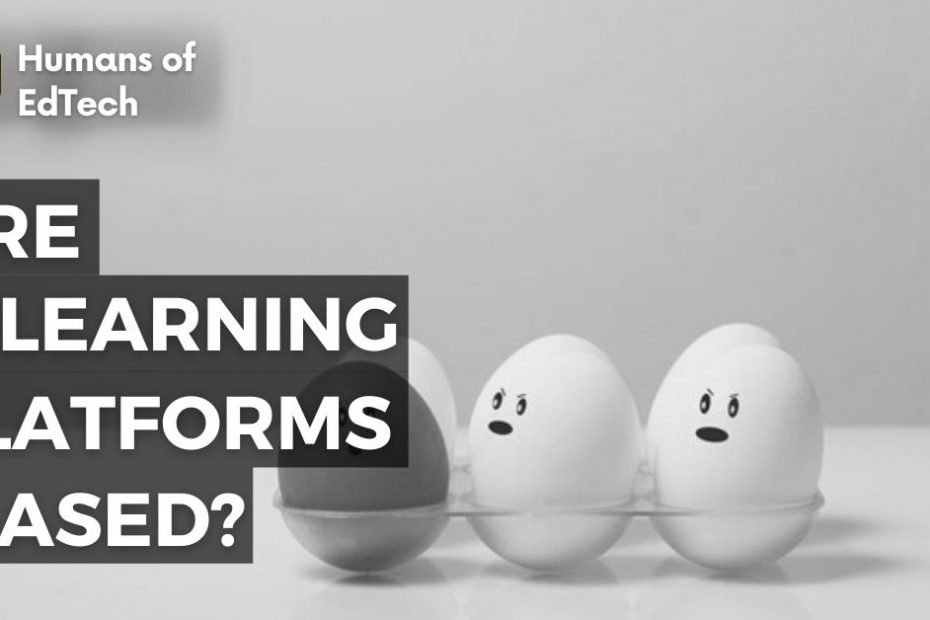We define bias in a human context. We rarely come across biased machine. Have you seen an ice cream vending machine that dispenses 20 grams extra to kids of certain ethnicity? Have you? Unlikely.
Of late, it is NOT uncommon to come across algorithms that show errors/ biases. Do you remember “google photos gorilla mistake”? Go search for it. The modern literature assigns this to training dataset errors and other fancy terms. For a layperson – this is bias.
If algorithms can be biased – don’t you think – software can be biased? e-learning platforms can be biased? You bet.
- Words:1250
- Type: Post
- Video:0
- Slides: 0
- Topic: Humans Of EdTech
- TIME: 8 Minutes
Here is an interesting read:
We all are aware, and maybe some of you have experienced that discrimination exists in the learning process. The partiality can be on various facets like male and female or rich and poor and many such things. But the point is this – the e-learning platform is biased to a certain set of people. Can we justify this? Is this by design?
E-learning platforms are best suited for all the learners for their greater efficiency. It is best known for providing worldwide skills and courses under the guidance of a well-experienced teacher. The learner learns unique skills in a much shorter duration and at any place. It requires no physical presence.
Discrimination based on gender is quite prominent in society. They state females as the minority, while males are the majority. Dealing with this in a social context is a whole different ball game. But with a piece of software/ Dataware e-learning platform, it is a little tricky to explain the biases.
e-learning platforms and the biases
We find it that in some platforms – the robots to ALSO have some biases. This may be because the developer lacks the business context OR annotations in data have led the model to go astray. There is to0ns of documentation out there on algorithms gone rogue. So this is very important to keep a careful watch on the unfair algorithm to avoid any kind of discrimination.
There are certain important things that you should know about bias in the e-learning platform. They are:
1. The first thing is that bias can be natural as well. A natural bias is a cognitive phenomenon that can’t be neglected or denied. It is natural when tons of queries are asked off the human brain. Here, the brain uses pseudo-reflexes to answer the queries. It prioritizes things accordingly and answers. All this is normal, but the trouble arises when this natural bias becomes unconscious and acts according to that. It is extremely important that you know biases are playing up. If you turn blind to it – things go downhill pretty fast from there on.
2. The second which you must keep in mind is that bias is present on the e-learning platform. You can’t just get away from it. Here, I would like to mention research that happened at Stanford University which had a strong emphasis on the presence of bias on e-learning platforms. It is very important to be aware of this because now most of the learners are enrolling themselves in the e-learning platform. And in the future, it will be a prominent platform that will educate millions of students.
3. The third point is the most important one, which is about unconscious bias. It is the judgment made in favor of any certain section OR the judgment made against another group. It is definitely an unfair decision. Many researchers believe that unconscious bias occurs because of the decisions made by the brain in a hurry, or you can say a brain uses a shortcut method.
In the e-learning platform, unconscious bias is a big hindrance, because no learner would like to be treated partially. It becomes quite difficult for learners to deal with such situations and study. So, it is the duty of the developer of the course to eradicate this kind of bias from the platform for a fair user experience.
Listed below here, are some ways by which you can try to eradicate the unconscious bias from the e-learning platform. They are:
Let the developer know about the course bias: This is the best thing to do if you feel that unconscious bias exists on the e-learning platform that you are using. There must be a forum on the e-learning platform which could connect you with the instructor to whom you can tell. You can either write an email or fill the required form so that the concerned team may contact you for further action. There are certain tools also available online which you can use to detect unconscious bias on the platform.
Avoid giving more personal information: Providing too much identification about yourself to the e-learning platform can cause unconscious bias. Limited information like your name and things related to the studies is fine, but things like gender, religion, and such things increase the chances of unconscious bias. With this format, one of the e-learning platforms enforced the single-gender identity, in which the learner doesn’t require mentioning his/her gender. This way the platform was upto much extent and was successful in eliminating the unconscious bias. Because of less information the brain has many options to find shortcuts and judge.
Presence of diversity in the course: This is important because it helps in developing associations with the learner. The e-learning platforms must include speakers, trainers, or teachers from all backgrounds. This is done to avoid any kind of discrimination and creating a sense of equality among the learners. Always remember to take feedback from the learners. This will allow the learners to present their point of views and expectations or any improvement they feel like to be done.
Train the teachers: This is one thing that the e-learning platform can do to eradicate stereotyped characters. In this way, the teachers and the instructors can identify the unconscious bias and help in eliminating it. The online classroom should be free from all kinds of discrimination and the learners should feel free to express their views.
More ways to fix the bias
- Adopt approaches taken by Peer-reviewed Journals. Whatever information we feel is biasing the actions of the stakeholders – mask it partially or completely.
- Content creators need to understand and cater to various modes of learning. Aural, Kinesthetic, Video based, etc. This can fix a lot of biases.
- Annotate the various areas within the product and learning content material on best ways to consume it.
- Ask for feedback. Important to listen to data. Also, listen to murmurs in sub-cultures on your platform.
- Conduct cohort analysis to see if a certain subgroup is consistently excelling or falling behind. Try to check if we can attribute this to factors like ethnicity, age group, information disclosure. A simple multivariate analysis may open up quite a few doors.
Conclusion
Elearning platforms are an important part of the learning process. It should be kept free from sorts of discrimination and favoritism. The learners enroll here with many expectations and aims in minds, so their hopes should not be judged on the basis of gender, race, etc.
It is very well said that “unity lies in diversity”, and therefore it should not be broken in any case. Unconscious bias is a very big obstacle in the path of the learner and stops them from achieving their goals. A diverse and multicultural environment is a must for all learners.
Photo by Leah Kelley from Pexels.
Join to get sneak peek into what's happening
I write about books, experiences, product, UX, EdTech, early stage growth, validation – mostly tech. Subscribe if these topics interest you. Once every 15 days emailer. I promise – No spam. (I am known for it otherwise) 😉




